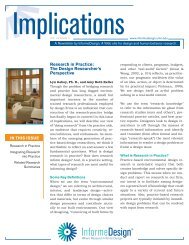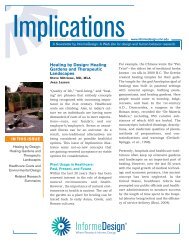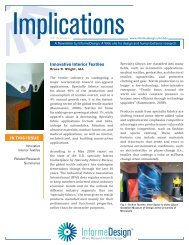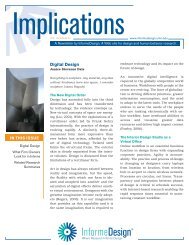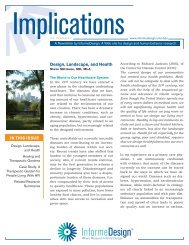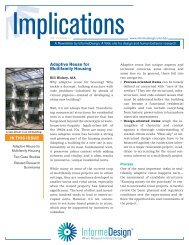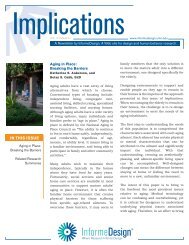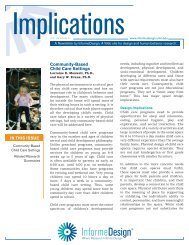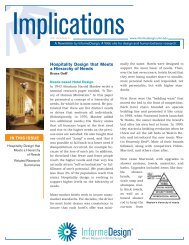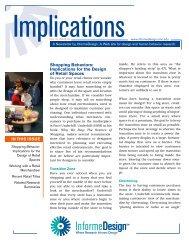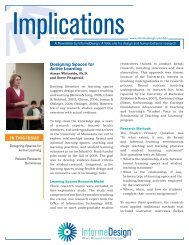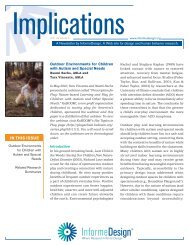Strategies for Designing Effective Restaurants - InformeDesign
Strategies for Designing Effective Restaurants - InformeDesign
Strategies for Designing Effective Restaurants - InformeDesign
You also want an ePaper? Increase the reach of your titles
YUMPU automatically turns print PDFs into web optimized ePapers that Google loves.
Implications<br />
slower periods, and allows guests to feel connected to<br />
but not necessarily part of a larger group.<br />
The emotional connection we have with a restaurant<br />
also contributes to our desire to eat there and to our<br />
purchasing behavior. Zaltman (2003) suggests that<br />
as much as 95% of a purchasing decision is based on<br />
emotional response rather than rational consideration.<br />
Also, a positive emotional reaction is the<br />
strongest indicator of loyalty to a business. Good<br />
restaurant designers start the creative process by<br />
asking the restaurant owner what kind of emotional<br />
experience is intended <strong>for</strong> the space, and how he or<br />
she wants guests to feel as they leave. If an owner<br />
indicates that the intention is <strong>for</strong> an exciting, transporting<br />
evening of exotic tastes, the design might<br />
include stimulating elements such as high contrast<br />
in colors and textures, dramatic lighting, and tighter<br />
seating placement. Conversely, if the restaurateur<br />
intends the guest to feel nurtured and refreshed, a<br />
very different approach to materials, seating type and<br />
placement, and atmospheric effects might be selected.<br />
Care needs to be taken, however, to ensure that<br />
the design doesn’t become too chaotic or conflict with<br />
the other elements of the experience, namely the food<br />
and the personal service.<br />
You Are Where You Sit<br />
Dissimilar from most settings, full-service restaurants<br />
rarely offer their guests the opportunity to<br />
choose their own seats. This is because restaurant<br />
managers strive to match the party size to available<br />
tables. That way, as many seats as possible are occupied<br />
at any one time and the workload of servers and<br />
the kitchen is balanced. Based on these factors, service<br />
runs smoothly. Thus the hostess does more than<br />
just “greet and seat;” she plays a very important role<br />
in the ongoing success of the business.<br />
But given a choice of where to sit in a restaurant, a<br />
substantial majority of people prefer sitting at a table<br />
www.in<strong>for</strong>medesign.umn.edu<br />
2<br />
next to some kind of permanent architectural feature:<br />
a window, a wall, or even a low partition. This<br />
“anchoring” behavior is most likely related to psychological<br />
needs: we need personal space around us to<br />
feel com<strong>for</strong>table. We try to define and defend our personal<br />
space by using elements of the environment as<br />
well as body position and eye contact to limit opportunities<br />
<strong>for</strong> encroachment. While research has<br />
shown that different cultural groups have different<br />
definitions of how much personal space is desirable,<br />
we have found that restaurant seating preferences<br />
are relatively consistent across multiple cultural<br />
groups.<br />
Food court seating behavior: “anchoring” of patrons to<br />
architectural features.<br />
An interesting, recent study suggests that a more<br />
important indicator of where guests prefer to sit is<br />
the type of dining occasion and the relationship to a<br />
diner's companions. Those surveyed, identified seats<br />
in the window as being most desirable <strong>for</strong> status<br />
occasions: romantic dinners or intimate meals with<br />
friends. However, when the dining occasion involved<br />
a significant difference in status or power between<br />
the participants—such as a job interview over a<br />
meal, seat preferences changed to heavily anchored,<br />
corner tables. And on occasions where diners ate<br />
alone, the strong preference was <strong>for</strong> an anchored<br />
Where Research In<strong>for</strong>ms Design ®



